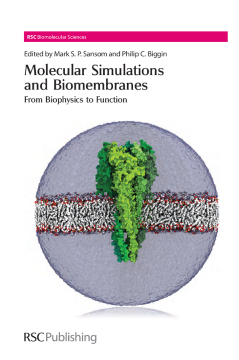
BOOK
Molecular Simulations and Biomembranes
Peter Tieleman | Ilpo Vattulainen | Emad Tajkhorshid | Jonathan W. Essex | Martin B. Ulmschneider | Klaus Schulten | Janice L. Robertson | Benoit Roux | Syma Khalid | Mark S P Sansom | Philip C. Biggin
(2010)
Additional Information
Book Details
Abstract
The need for information in the understanding of membrane systems has been caused by three things - an increase in computer power; methodological developments and the recent expansion in the number of researchers working on it worldwide. However, there has been no up-to-date book that covers the application of simulation methods to membrane systems directly and this book fills an important void in the market. It provides a much needed update on the current methods and applications as well as highlighting recent advances in the way computer simulation can be applied to the field of membranes and membrane proteins. The objectives are to show how simulation methods can provide an important contribution to the understanding of these systems. The scope of the book is such that it covers simulation of membranes and membrane proteins, but also covers the more recent methodological developments such as coarse-grained molecular dynamics and multiscale approaches in systems biology. Applications embrace a range of biological processes including ion channel and transport proteins. The book is wide ranging with broad coverage and a strong coupling to experimental results wherever possible, including colour illustrations to highlight particular aspects of molecular structure. With an internationally respected list of authors, its publication is timely and it will prove indispensable to a large scientific readership.
Philip Biggin is a Senior Research Associate in the Department of Biochemistry at the University of Oxford. His research interests lie in receptor-ligand interactions, comparative dynamics of proteins and bioinformatics of ligand-gated ion channels. He is the author of over 30 peer-reviewed papers and he sits on the Oxford Supercomputing Centre management committee. He is currently a consultant to BioMedCentral on the development and implementation of cysloopDB, a database that stores all of the physiological and pharmacological data for the cys-loop family of ligand-gated ion channels. He is a member of the Royal Society of Chemistry, the British Biophysical Society, the Biochemical Society, the US Biophysical Society, and the Molecular Graphics and Modelling Society. Mark Sansom is a Professor in the Department of Biochemistry at the University of Oxford, and Director of the Structural Bioinformatics and Computational Biochemistry Unit (http://sbcb.bioch.ox.ac.uk). He has worked on modelling and simulations of membrane proteins for over 15 years. He heads a research group of about 25 people working on topics ranging from the dynamics of water in nanopores to large scale MD simulations of bacterial membranes. This is currently funded by BBSRC, the Wellcome Trust, the EPSRC (as part of the bionanotechnology IRC), and MRC. He is the author of about 275 papers and reviews. He has an interest in HPC and in GRID computing for biomolecular simulation applications, and heads the BioSimGrid (www.biosimgrid.org) and IntBioSim (www.intbiosim.org) projects, in addition to a project (funded by BBSRC and IBM/HPCx) to develop a virtual outer membrane. He is a member of the High End Computing Strategy Committee, and the HPC Trends and Opportunities Panel (representing BBSRC interests on both), and chairs the Hector Science Board. He is an editorial board member for several journals, including Biophysical Journal, Physical Biology, Protein Engineering, Selection & Design, and Molecular Membrane Biology. He is also a Fellow of the Institute of Physics, and a member of the Biochemical Society, the US Biophysical Society, and the Physiological Society.
